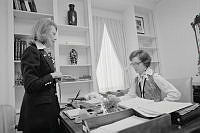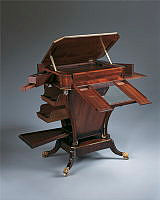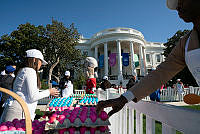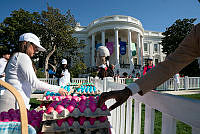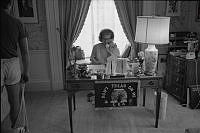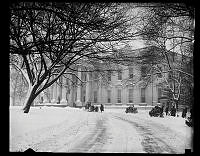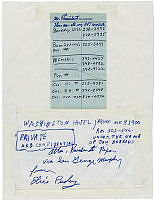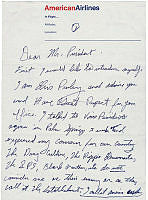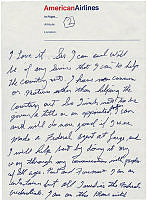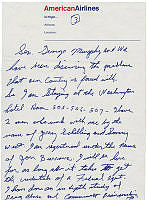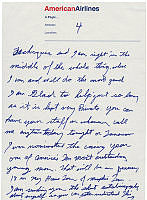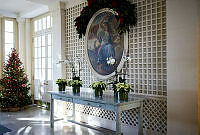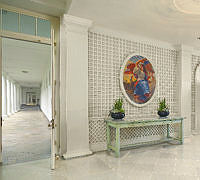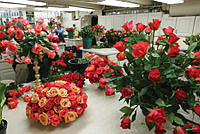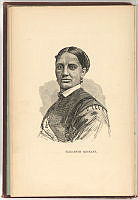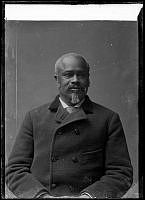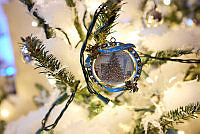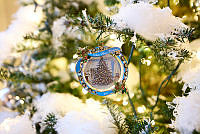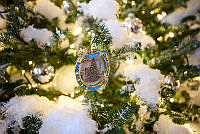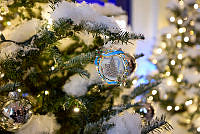"A Well-Ordered Household"
Domestic Servants in Jefferson's White House
Copyright © White House Historical Association. All rights reserved under international copyright conventions. No part of this article may be reproduced or utilized in any form or by any means, electronic or mechanical, including photocopying, recording, or by any information storage and retrieval system, without permission in writing from the publisher. Requests for reprint permissions should be addressed to books@whha.org
One morning in early December 1802 a Federalist senator, just arrived from New Hampshire, was ushered into the President’s House with some fellow legislators. After a few moments “a tall highboned man” entered the room, wearing “an old brown coat, red waistcoat, old corduroy small clothes, much soild—woolen hose—& slippers without heels.” William Plumer later wrote a friend, “I thought this man was a servant; but Genl Vamum surprised me by announcing that it was the President.”1 Plumer made no mention of the actual servant who had admitted him, resplendent in a new suit of blue and red, trimmed with silver lace.2
The contrast between Thomas Jefferson's personal appearance and the elegance of his surroundings was cause for comment throughout his eight years in the Executive Mansion. Hostile Federalists and disdainful British diplomats grumbled about a president as careless of his clothing as of customary etiquette. Even friendly observers remarked on the contradictions in his behavior. “However he may neglect his person,” wrote Mahlon Dickerson in 1802, Jefferson “takes good care of his table. No man in America keeps a better.”3
Others echoed Dickerson’s assessment of Jefferson’s table, the central focus and emblem of the well-regulated household he had been shaping from the start. Back in early 1801, Jefferson had pondered the formation of two administrations, one public and one private. The day after his election in the House of Representatives on the 36th ballot, he started to issue official invitations to prospective cabinet members. Three days later, even before asking Meriwether Lewis to be his private secretary, Jefferson sent off letters in search of a cook and a steward—or rather a chef de cuisine and a maître d’hotel.4 He wrote to Philippe Létombe, the French envoy in Philadelphia: “Being now obliged to fix myself here, I find as great difficulty in composing my household, as I shall probably find in composing an administration for the government. You know the importance of a good maître d’hotel, in a large house, and the impossibility of finding one among the natives of our country. I have imagined that such a person might be found perhaps among the French in Philadelphia.”5
In a city with thousands of French residents, Létombe did find such a person. For the first six months of Jefferson’s presidency, Joseph Rapin gave “the most perfect satisfaction” in the position of majordomo.6 His replacement was Etienne Lemaire, a “portly well-mannered frenchman,” previously in the service of wealthy Philadelphian William Bingham.7 Lemaire was remembered by Jefferson’s grandson as “a fine looking man[,] honest and highly accomplished in his line.”8 Margaret Bayard Smith recalled that Jefferson’s “maitre-d’hôtel had served in some of the first families abroad, and understood his business to perfection.”9 It was Lemaire who choreographed the presidential entertainments, in the French style that was the height of fashion in the new republic.

This unglazed porcelain bust of Thomas Jefferson was created by the National Porcelain Factory of Sèvres in 1908. The bust is based on a well-known bust of Jefferson sculpted by French artist Jean Antoine Houdon in 1789. The author of the Declaration of Independence, Jefferson served as president from March 4, 1801 until March 4, 1809.
White House Collection/White House Historical AssociationObservers duly noted the French cast of both Jefferson’s politics and his hospitality. John Quincy Adams’s wife listed the “French Servants in Livery; a French Butler, a French Cuisine, and a buffet full of choice wine,” most of it French.10 The admiring Margaret Bayard Smith recalled that “republican simplicity was united to Epicurean delicacy; while the absence of splendour ornament and profusion was more than compensated by the neatness, order and elegant sufficiency that pervaded the whole establishment.” Jefferson expressed his keen sense of the proper limits of grandeur in an injunction to his steward: “While I wish to have every thing good in it’s kind, and handsome in style, I am a great enemy to waste and useless extravagance, and see them with real pain.”12
When Jefferson was unsuccessful in persuading his former slave James Hemings to return to his service as chef, Létombe found another Frenchman to fill the second position in the household.13 Honoré Julien, aged 42, had been in the country for almost 10 years and had worked in George Washington’s kitchen in the last four months of his presidency.14 According to Mrs. Smith, his “excellence and superior skill” were acknowledged “by all who frequented [Jefferson’s] table.”15 Congressman Samuel L. Mitchill wrote that Jefferson’s cook “understands the art of preparing and serving up food, to a nicety.”16
In the third position in the domestic hierarchy was the coachman and head of Jefferson’s stables. Jefferson later described Joseph Dougherty, a native of Londonderry, Ireland, and a hold over from the staff of John and Abigail Adams, as “sober, honest, diligent, & uncommonly intelligent in business.”17 While Federalists deplored the new president’s habitual mode of travel— “a single horse,” with no servant in attendance— Dougherty was also chagrined, as he seldom got to mount the box of the elegant presidential chariot.18 Over the years, however, his responsibilities expanded beyond the horse stalls and carriage bays. As Jefferson later wrote, Dougherty served “rather as a riding agent than as the head of my stable.”19
It must have been these three servants, who served for the full eight years, that Margaret Bayard Smith had in mind when she wrote that Jefferson “secured the best services of the best domestics, not only by the highest wages, but more especially by his uniform justice, moderation and kindness and by the interest he took in their comfort and welfare. . . . During the whole time of his residence here, no changes, no dismissions took place in his well-ordered household.”20

A liveried black servant, Billy Lee, is seen standing in the back of The Washington Family by Edward Savage (1798-96). George Washington's red and white livery derived from his coat of arms.
Library of CongressThere was less stability, however, among the lower-ranking servants, although none is known to have been actually fired. The men who played a shifting variety of roles as footmen, waiters, and porters were, besides Lemaire, the most conspicuous representatives of the domestic staff. In a society where livery was rare, they wore splendid uniforms: blue broadcloth coats with “crimson” or “scarlet” collar and cuffs, plated buttons, and a decorative woven edging, in silver, called livery lace; red waistcoats; and velvet or corduroy pantaloons —not knee breeches.21 Whereas George Washington’s red and white livery derived from his family coat of arms, the blue-and-red color scheme used by Jefferson was by this time a generic standard for servants’ uniforms in Britain and America.22 This liveried corps included Irishmen, a German, possibly a Spaniard and a Frenchman, an American soldier, and an enslaved African American.23 Besides their visible roles in greeting visitors, waiting at table, and attending to guests, these men shouldered the major burdens of fetching, carrying, and cleaning behind the scenes. Jefferson revealed their multiple duties when he sought “one who could act as porter, and at the same time take care of the Cabinet, setting room, and Oval room, leaving the Dining room and hall for John [Freeman], He should be sober, diligent and good-humored.”24
Abraham Golden did double duty as footman and manservant for Meriwether Lewis and Lewis’s successor as Jefferson’s private secretary.25 When Golden decided that a life at sea was preferable to one of service, John Pernier—variously described as a free mulatto, a Creole, and a Spaniard—filled his spot for another three years, leaving in 1807 with Lewis when he returned to the West as governor of Louisiana Territory.26 Robert Dougherty, the coachman’s brother, took the position for the remainder of Jefferson’s term.
Despite having trusted enslaved domestics at Monticello, Jefferson brought only three slaves to the President’s House, a succession of apprentice cooks. As he wrote in 1804, “At Washington I prefer white servants, who when they misbehave can be exchanged.”27 Yet one of his favorite Washington domestics was an enslaved man. Jefferson hired John Freeman, aged about 20, from a Maryland physician, and purchased him in 1804, the contract specifying that he become free in 1815.28 A document of 1827 reveals that Freeman was five feet seven inches tall, “straight and well made . . . very pleasing countenance.”29 Freeman’s duties included waiting at table, care of the hall and dining room, and possibly some personal attendance on the president. Jefferson had no servant who could be described as a valet de chambre, wholly dedicated to the care of his clothes and person. In fact, as a grandson-in-law, Nicholas Trist, recalled, Jefferson usually did without a “body servant,” as the term was then understood. Trist cited a Jeffersonian maxim, “Never allow another to do for you what you can do for yourself,” and added, “It was incompatible with the sentiment of Manhood, as it existed in him, that one human being should be followed about by another as his shadow.”30
This aversion to the presence of a servant was the source of anguish for Jefferson’s family members until his death. In 1803, for instance, his daughter Maria Jefferson Eppes deplored “the unsafe and solitary manner” in which her father slept upstairs in the President’s House.31 John Freeman was nevertheless important to Jefferson, accompanying the president on all his journeys to Monticello. In 1803, Jefferson sent Freeman to Monticello as escort for his departing daughters. After their arrival, Maria Eppes wrote her father that the horses “will set off tomorrow with John, whom I hear you have miss’d very much in the dining room.”32 Another African American, a free man named John (Jack) Shorter, was a stablehand from the fall of 1801 to the spring of 1809.33

This architectural sketch of the North Front of the White House was drawn by Samuel Blodget, Jr., a merchant and amateur architect and artist. A fainter inscription, possibly added by a different individual, indicates the sketch was made "in the Presidency of Jefferson and Madison" or sometime between 1801-1817. Blodget added the carved laurel branches, which were not in place at the time of the sketch.
White House Collection/White House Historical AssociationThere were also women workers in the presidential household, although their duties are largely unclear. Joseph Dougherty’s wife, Mary, was on the staff for almost the entire eight years. The wives of Honoré Julien and footman Christopher Süverman worked for shorter periods. Sally Houseman and Biddy Boyle were resident washerwomen, assisted by local women hired in busy periods. Most of the nonresident workers were free blacks. Lemaire’s accounts repeatedly refer to the “négres” and “négresses” he hired on a daily or weekly basis for special jobs like cleaning the privies, sweeping the chimneys, taking care of the infants of the trainee cooks, and tending the presidential flock of sheep.34
Into this household of multiple nationalities were introduced three young women who had never left Albemarle County, Virginia. Jefferson began preparing for his retirement in 1801, when he brought an enslaved 14-year-old from Monticello to learn the art of French cookery in Julien’s kitchen. Ursula arrived at the largest house in the first city she had ever seen, staying only a year. Edith (Edy) Fossett, aged 15, replaced her in the fall of 1802, remaining for six and a half years. Her sister-in-law Fanny Hem, aged 18, joined her in the fall of 1806 and returned to Monticello in spring of 1809.35
The cast of characters is completed by mentioning a series of scullions, Jack, Isaac, and Sandy, who were probably free blacks. In the first three years, there was also a more highly paid garçon de cuisine named Noel. For most of his presidency, Jefferson had a staff of 11, managing with only 10 for the last year and a half. Their wages, like all the costs of stocking and running the President’s House, came out of his own pocket. With an annual salary of $25,000, he had the deepest pockets of his life. Still, it took close to 15 percent of his income to feed, clothe, and pay his servants.36 Their wages never varied over the eight years. No one received, or evidently even expected, a raise. In 1802, relieved that a new footman had been found, Jefferson wrote about another candidate: “Some difficulty might have arisen from the proposition for 18. dollars a month, lest that should have furnished grounds to the other servants to whom I give but 14 D. including drink to expect a rise of their wages.”37 The “drink” figure was a customary gratuity of $2 a month for everyone except Lemaire and Julien, who, as quasi-gentlemen in a kind of class of their own, were not tipped. “Drink money” was the only remuneration for the enslaved household workers.38
Despite his expressions of trust in Lemaire, Jefferson kept a close watch on the transactions of his factotum, through whose hands passed as much as $10,000 in cash each year.39 Every weekend Lemaire compiled and handed in his accounts, which Jefferson analyzed and transcribed into his memorandum book on Mondays. This analysis involved ever more complicated computations, by which Jefferson sought to gauge the costs of his entertaining. He kept a running record of the weekly average cost of each guest’s dinner, and, from 1802, he separately calculated weekly expenditures for meat, vegetables, butter, and eggs. He compared the costs of dinners when Congress was in session and when it was not, and it is no surprise that he also determined how expensively his servants were eating during his twice-yearly absences.40
The Family
Margaret Bayard Smith, the only Washington commentator to discuss the servants in the President’s House at any length, wrote that, “without an individual exception they all became personally attached to [Jefferson].... In sickness he was peculiarly attentive to their wants and sufferings, sacrificing his own convenience to their ease and comfort.”41 She also reported that, when describing the harmony of his political administration, Jefferson said that “we were one family.”42 Everyone from scullion to steward was also “family,” according to its then customary meaning of an entire household. In his search for a maître d’hotel, Jefferson had asked for someone who could “take charge of the family.” Every summer Lemaire and Joseph Dougherty wrote to Monticello some variation of “all the family are well.” A Washington physician who cured the ills of Jefferson’s servants wrote out a bill for “Attendance on the President’s Family.”43

The doctor's bill for President Jefferson's household dated March 22, 1802, lists the medical services provided to several servants by Dr. Edward Gantt.
The Thomas Jefferson Papers at the Library of CongressLike all families, this one had its share of misfortune and discord. Doctor’s bills and letters reveal that servants were often incapacitated by illness.44 In March 1807, when Jefferson was suffering from his “periodical headache” and his son-in-law was convalescing after a dangerous illness, he reported that “indeed we have quite a hospital, one half below and above stairs being sick.” Lemaire was “seriously ill” and John Freeman “just getting about after 6 weeks confinement with a broken jaw.”45 The presence of young children (of the Doughertys and the enslaved cooks) meant the dreaded diseases of infancy stalked the cellars of the mansion. A boy died in Jefferson’s absence in the summer of 1802, and whooping cough carried off Fanny Hem’s child in November 1808. Lemaire made several poignant entries in his account book, payments for a coffin made by Peter Lenox and other burial expenses.46 Of at least five children born in the President’s House to the Monticello cooks, only two, James and Maria Fossett, survived to adulthood.47
The marriages of the enslaved women felt the strains of separation. Husbands were at Monticello and wives were more than 100 miles away, in a city with a vibrant and quickly growing African American population. Fanny Hern was able to see her husband for a day or two, at intervals. David Hem, a wagoner, journeyed alone to the Federal City twice a year, transporting plants and supplies between Monticello and the President’s House. Nevertheless, as former Monticello overseer Edmund Bacon recalled, they got into “a terrible quarrel,” Jefferson was “very much displeased,” and Bacon was summoned to the capital to take them to Alexandria for sale. When the overseer arrived, the Hems “wept, and begged, and made good promises, and made such an ado, that they begged the old gentleman out of it.”48
Edy Fossett’s husband, Joseph Fossett, made an unauthorized journey to Washington when he heard disturbing news from John Freeman or Jack Shorter, soon after their arrival with the president at Monticello in July 1806. The enslaved blacksmith left his forge and set out on foot on a road he had never before taken. Jefferson’s reaction was swift. He hired a local man to follow the runaway and alerted Joseph Dougherty: “We know he has taken the road towards Washington, & probably will be there before the bearer. He may possibly trump up some story to be taken care of at the President’s house till he can make up his mind which way to go; or perhaps he may make himself known to Edy only, as he was formerly connected with her.” The Irishman reported the capture: “After returning from a cruise where I got wind of him I met with him in the Presidents yard going from the Presidents House.... I took him immediately & brought him to Mr. Perry & has him now in jail. Mr. Perry will start with him tomorrow for Monticello.” Lemaire commented on the events as well: “The poor unhappy mulatto got [i.e., Joe] was not difficult to take. He well merits a pardon for this.”49
Jefferson’s biannual migration pattern had further consequences. When at Monticello in 1803, John Freeman became engaged to Melinda Colbert, an enslaved domestic servant of Jefferson’s daughter Maria Jefferson Eppes and a granddaughter of Elizabeth (Betty) Hemings. Freeman planned to ask Mrs. Eppes’s permission to marry Melinda during the Monticello visit of April 1804, but Jefferson’s daughter died on April 17. Her death devastated Jefferson and alarmed John Freeman and Melinda Colbert, who recognized the increased threat of separation for enslaved spouses owned by two different people. The very next day Freeman took up his pen to appeal to the grieving president, who was in the same building. In essence, he asked Jefferson to purchase them both. Jefferson did buy Freeman a few months later, but he declined to purchase Melinda from his son-in-law, explaining that he already had too many house servants “in idleness” at Monticello and, besides, “John knew he was not to expect her society but when he should be at Monticello, and then subject to the casualty of her being here or not.”50

The kitchen of a large household such as the White House was often a center of bustling activity. This illustration from Universal Household Cook shows a kitchen c. 1795.
From Universal Household CookRelations within the free families were not entirely harmonious. Footman John Kramer left his wife and the President’s House at the same time.51 Joseph and Mary Dougherty’s marital difficulties rose to such a pitch in the summer of 1807 that the coachman also left Jefferson’s employ, but he returned to his wife and the presidential stables in the fall. News of their reconciliation caused Jefferson to write: “The differings between man & wife, however they may affect their tranquility, can never produce such sufferings as are consequent on their separation.”52 Back in 1802, Dougherty, also one who preferred to write his master rather than speak to him on a difficult topic, revealed some of the cracks in the solidarity of the domestic staff. After stating that “what I have to communicate to you is more than I can do when face to face,” he cataloged the various misdemeanors of footman Christopher Süverman and his wife Betsy, pilfering the linens among them.53 Jefferson’s response, presumably verbal, no doubt accorded with his policy for dealing with disputes among his hired Monticello workmen: “It is my rule never to take a side or any part in the quarrels of others, nor to enquire into them. I generally presume them to flow from the indulgence of too much passion on both sides, & always find that each party thinks all the wrong was in his adversary.”54
The presence of an enslaved African American clothed and considered as the other footmen was bound to be a source of resentment. John Freeman spoke of being “treated with a great deal of hostility in your family.”55 In his very first month, footman Edward Maher was heard complaining that Jefferson “gave preference to a negro rather than to him in following you.” Rapin the steward continued: “I myself heard him murmuring, saying that he would not wear the same sort of outfit as a negro wore, in speaking of the livery.” Jefferson gave short shrift to these sentiments. He replied that he did not yet know Maher well enough to value him, but “the negro whom he thinks so little of, is a most valuable servant.”56 Jefferson was not distressed when Maher left his service in 1802, considering him “a very capable servant, but stands too much on etiquette. I like servants who will do every thing they arc wanted to do.”57
One Day’s Round
On April 3, 1807, it is assumed that the servants did everything that was expected of them. This was a quiet day, with no open houses or dinner parties. The “fatigues of the table” were over, as the members of Congress had abandoned the capital a month earlier, and the president was about to leave for his spring break at Monticello.58 Jefferson was an early riser, always up in time to check his thermometer at sunrise, which on this morning was just before 6:00 a.m. He marked down the dawn temperature as 32 degrees, the hygrometer at 6.8, the weather fair, and the wind from the southwest. His secretary, Isaac A. Coles, whose bedroom was a floor below in the East Room, also checked the thermometer and weather vane, noting the same results. A slightly more voluble diarist than the president, Coles described the day as “disagreeably cold.”59
By the time these men were up and recording the weather, most of the other residents of the President’s House had been on their feet for hours. At the cellar level, Etienne Lemaire rose to marshal his forces from his bed in the room below the oval drawing room. The footmen were launched on their morning tasks of carrying firewood and coal to the hearths and water to the bedrooms, and dusting and tidying on the first floor— John Freeman in the Entrance Hall and dining rooms and William Fitzjames in the drawing room, the adjacent sitting room, and Jefferson’s cabinet.60 Robert Dougherty and John Pernier resumed a perpetual round of polishing the silver, not to mention the boots of the upstairs inhabitants—besides Jefferson and Coles, Meriwether Lewis and Jefferson’s son-in-law Thomas Mann Randolph.

In this letter to Thomas Mann Randolph dated January 1, 1802, Jefferson writes of the events of the day including ordering a waterproof coat. He also describes the presentation of the famous mammoth cheese, a gift of his supporters in Cheshire, Massachusetts, which weighed more than a ton.
The Thomas Jefferson Papers at the Library of CongressWith the domestic mechanism set in motion, Lemaire would usually have walked to the stables. On market days, Jack Shorter harnessed the carthorse to the wagon, Joseph Dougherty took the reins, and he and Lemaire set off to purchase provisions. The day before, at the Center Market, Lemaire had purchased salted beef, chickens, butter, spinach, watercress, and parsley. There was, however, no market on this day, a Friday.61
In the enormous room under the north Entrance Hall, the kitchen staff kept the fires burning in a fireplace, an iron range, and a stew-stove. Sandy the scullion filled a scuttle with charcoal for the latter, where pots of coffee and hot chocolate sat on grates above its cast-iron stew-holes. After Fanny Hem scattered com for the hens and ducks in the poultry yard and gathered up the new-laid eggs, she met the cart of Miller the dairyman and carried in the day’s milk and cream. Edy Fossett was preparing the breakfast breads, while Julien and Lemaire put their heads together to settle on a menu for dinner. Mary Dougherty was on her way to the cupboards to get linens for the breakfast table.62
While his servants fetched, carried, chopped, and stirred in the nether regions, the master of the house embarked on a routine that would minimize their visibility. After his session with William Conner the barber, he came downstairs to his cabinet about 6:00 a.m. and dashed off orders for books and two tons of nailrod for the Monticello nailery.63 William Fitzjames was probably the first of the footmen to don his livery uniform, trading his behind-the-scenes cleaning role for a more ceremonial position as doorkeeper. The only known visitors were the four heads of department, who came for a “consultation” on issues of national security—the Bun-conspiracy and the unpalatable Monroe-Pinkney treaty with Great Britain.64 This morning meeting, which extended through the dinner hour, meant that Jefferson must have missed his midday ride. But he may have mounted Wildair at an earlier hour than usual, since he saw Jack Shorter, the stablehand, paying him for a valise pad.65 The absence of an attending servant on Jefferson’s daily rides shocked Washington society and spawned numerous stories of his encounters with citizens who abused their president without realizing they were conversing with him.66
Even if Jefferson did not take his daily ride, there would have been activity in the stables, where Wildair, four high-blooded bay carriage horses, and the carthorse required currying and feeding. In the carriage bays were a chariot, two phaetons, a gig, and the market wagon. Jack Shorter had to clean harness and haul oats and hay. Joseph Dougherty would have been anxious to ensure that the phaeton, gig, and horses were ready for Jefferson’s and Randolph’s journey to Monticello four days hence.67
While Jefferson, James Madison, Albert Gallatin, Henry Dearborn, and Robert Smith discussed impressment on the high seas, steam rose from copper stewpans of soup and beans in the kitchen and from a copper boiler in the wash house in the west dependencies wing, where Biddy Boyle wrestled with sheets and pillow cases.68 Julien directed Edy Fossett in putting together his specialty of the day, “partridge with sausages & cabbage a french way of cooking them.” Revolving on the roasting jack before the hearth was a quarter of bear that Lemaire had purchased at market six days earlier. He was anxiously watching Fanny Hem stir an egg custard for the centerpiece of the dessert course.69 When searching for a steward, Jefferson had specified that “honesty and skill in making the dessert are indispensable qualifications.” Maîtres d’hôtel were proficient in food preparation, especially the dessert, although they were usually not expected to wield the knives and whisks themselves. Contemporary commentators extolled the presidential meals as if a single French chef were responsible, but Lemaire and Julien should get joint credit.70
Honesty and skill in making the dessert are indispensable qualifications
Although Jefferson had given only one dinner party in the month since the congressional session ended, it is clear that standards of cookery and presentation had not been relaxed. Lemaire and John Freeman prepared the small dining room with their usual attention to the alignment of the tablecloth and the arrangement of the silver, china, and glass. The footmen, now all in livery for their role as waiters, brought the dishes of the first course up the stairs and placed them with a studied attention to symmetry on the table: a “ham of bacon” in the center, with a beef bouilli, the “quarter” of bear, the partridge dish, soup (perhaps cressonière, with watercress Lemaire purchased the day before), potatoes, rice, spinach, beans, lamb’s-lettuce salad, and pickles disposed about it.71 While this dining room did not have a revolving door with circular shelves for swiftly changing courses, as did the public dining room, another kind of dumbwaiter was almost certainly used—especially given the sensitivity of the business at hand. Since his residence in France, Jefferson had used these tiered tables between the diners to diminish the need for servants, “mute but not inattentive listeners,” in the words of Margaret Bayard Smith.72
Lemaire announced dinner at 4:00 p.m., and, after the president and his guests sat down at the table, the maître d'hôtel may have remained in the room, as he did for more formal dinners, “seeing that the servants attended to every gentleman but not waiting himself.” On this occasion it is more likely that the footmen withdrew, leaving their job to the dumbwaiters. In any case, Jefferson liked to fill the plates of his guests himself. Servants reappeared for the transition from the first to the second course, the all-important dessert.73 Lemaire always put the principal dessert in its place at the head of the table, on this day “a kind of custard with a floating cream on it.” For the bottom of the table there were “apples inclosed in a thin toast a french dish,” and “on each side four dishes & three in the middle,” probably holding cakes and jellies, as on the preceding days.74 When the nation’s leaders had taken their fill, the waiters removed the tablecloth along with the dishes and brought in the wines. If the same varieties Isaac Coles had noted two days earlier, they came from four nations: Portugese Madeira, Spanish Pajarete, French Hermitage, and Italian Nebbiolo. Accompanying the wine were “olives, apples, oranges & 12 other plates of nuts & co.”75
Coffee and tea were ready in the adjoining oval drawing room, so Jefferson and his fellow diners were now on their own. If they needed a servant for some special purpose—as in 1802 when Jefferson “ordered” his waterproof English greatcoat brought in for a test of its impermeability—the bell system, installed in 1801, was at hand to summon a footman from the servants’ hall in the cellar.76 There, and in the dining room, most of the household staff were dealing with the aftermath of this comparatively simple dinner party. They had dishes to wash, candles to extinguish and wicks to trim, linens and plated ware to lock up. One of the servants carried a tray to a small table with doors that “flew open” when a spring was touched. He stocked it, as usual, with “a goblet of water, a decanter of wine, a plate of light cakes, and a night-taper.” When showing this convenience to a guest, Jefferson said, “I often sit up late, . . . and my wants are thus provided for without keeping a servant up.”77
Etienne Lemaire was probably the last of the household to go to bed. He had to complete the ritual of closing down the house, checking that all was in its proper place and under lock and key, the doors and windows secure. He may have also wanted to begin to organize his accounts for the last five weeks, which Jefferson would analyze before his departure.78 Jefferson sipped his wine and transcribed the deliberations of his cabinet into his political journal at the end of a day so busy that—very unusually—he never made his afternoon observation of the thermometer. He retired in the knowledge that his household was humming along in a course very much “to [his] mind.”79 Its uniforms, the Gallic refinement of its furnishings and fare, and its reigning order provided a secure space for personal negligence and “republican simplicity.” Within the elegant confines of his castle, the president could rise the next day to receive his official visitors in his faded coat and worn slippers.

President Thomas Jefferson often used dumbwaiters to minimize the need for servants for his small dinners at the White House. This image of the dining room at his home of Monticello is a window into what dining in the White House at the time of Jefferson may have looked like.
Historic American Buildings Survey (Library of Congress)After 1809
Jefferson said farewell to his household staff on March 11, 1809, when he crossed the Potomac for the last time. Stable hand Jack Shorter accompanied him through a heavy snowstorm to Monticello, while Edy Fossett and Fanny Hem, with Edy’s children, made the journey more slowly in a caravan of wagons. Honoré Julien followed 10 days later in order to spend almost three weeks helping the “two good girls,” as Lemaire called them, to settle in to the new kitchen under the south terrace. Jefferson reported that Julien’s “pupils are going on very well and much to our comfort and satisfaction.”80 During the years of his retirement, Monticello visitors praised the “half Virginian, half French style” of the meals they prepared.81
Back in Washington, the remaining servants found other places and occupations. Margaret Bayard Smith, in her glowing account of master-servant relations in the President’s House, probably exaggerated when she wrote that Jefferson, “by his generous interference,” helped his former servants to make “some advantageous establishment for themselves.”82 But there is no question that he parted on very cordial terms with his employees, interested himself in their futures, and on occasions made them financial contributions. He, too, had to resort to the written word to express his sentiments at the moment of parting: “My heart was so full that I could utter but the single word Adieu. Indeed the enlivening idea of rejoining my family and of being once more master of my own time & actions, was lost in the moment of separation from those who had lived so long in the house with me, & served me so much to my mind.” In this letter to Lemaire, he declared his attachment to his “faithful, & skilful” steward, whose “whole conduct [was] so marked with good humour, industry, sobriety & economy as never to have given me one moment’s dissatisfaction.”83
Lemaire returned to Philadelphia and prospered for a time, but his life had a “tragical” end. In 1817 he threw himself in the Schuylkill River when a friend defaulted on a $5,000 loan. Although Lemaire had a fortune equal to twice that sum, “he lost both his health and his reason.”84 An unusual number of suicides are associated with residents of the President’s House of Jefferson’s time, and financial worries figure in all of them. Less well known than the death of Meriwether Lewis in 1809 is that of his servant, John Pernier, who “followed his master’s example” six months later by taking an overdose of laudanum. Despondent over his failure to be paid for more than a year’s service to Governor Lewis, Pernier was also perhaps troubled by rumors that he was Lewis’s murderer. In his last months, “wretchedly poor and destitute,” he was taken in by former President’s House footman Christopher Süverman, who bore the expenses of his final illness and burial. Jefferson described Süverman at this time as “a very honest man,” now completely blind, who bought and sold groceries “from hand to mouth” and was “miserably poor.”85
There is no question that [Thomas Jefferson] parted on very cordial terms with his employees, interested himself in their futures, and on occasions made them financial contributions.
At the time of Pernier’s suicide, Honoré Julien was making a modest but independent living on F Street selling cakes and confectionery, including, in the summer, ice cream. He also canned on a catering business. Over the years, he sent New Year’s greetings to Monticello and occasionally forwarded delicacies, like canvasbacks and Swiss cheese, that were unattainable in the mountains of Virginia.86 By 1828 his “cookshop” had been discontinued “for want of custom” and was a mere “fruit shop.” His death two years later was announced in the newspaper with the comment, “His probity and worth were proverbial.” He passed on his culinary skills, for his son Auguste Julien catered banquets at the President’s House in the time of James K. Polk.87 Honoré Julien’s enslaved pupils, after running Monticello’s kitchen for more than 15 years, were both sold at the estate sale after Jefferson’s death. Fanny Hem and her husband were purchased by University of Virginia professor Robley Dunglison. Edy Fossett and her youngest children were bought by free family members. Her husband, Joseph, who had been freed in Jefferson’s will, continued to work as a blacksmith to pay for the purchase of his wife and children. The Fossetts moved in about 1840 to Cincinnati, where their sons became the most prominent caterers in the city.88
The other slave in the President’s House, John Freeman, also had to struggle for freedom and family unity. On the eve of Madison’s inauguration, Freeman was again driven to take up pen and paper rather than put his case face-to-face. Jefferson wanted his slave to go with him to live at Monticello. By this time Melinda Colbert was Freeman’s wife and living in the President’s House, evidently now free. Her husband considered it unsafe for her to return to Virginia, so he had refused to go. His letter included an apology and a painful concession: “Rather than disples you i will go and do the best i can. ... 1 shall be oblige to leave [Melinda] and the children.”89 Jefferson bowed to the inevitable. He sold Freeman to Madison, who retained him as dining room servant in the President’s House. Freeman became free according to the original contract in 1815 and evidently continued to work for the Madisons while they remained in Washington.90 Afterwards, he was a waiter at Gadsby’s Hotel and a messenger in the State Department, among other unknown occupations. John and Melinda Freeman, who had at least eight children, were active in the antislavery endeavors of Washington’s free blacks. At his death in 1839, John Freeman was able to leave his family a house on K Street several blocks northwest the President’s House.91
Little is known of Freeman’s companion of the road, Jack Shorter. In 1819 he sent word of his “present state” to Jefferson through Joseph Dougherty, his former taskmaster. After his wife had left him to go to “the western country,” Shorter became “dissipated” and unable to make a living. As Dougherty reported, he “flew to me for protection. I succeeded in reforming him.”92 Dougherty’s own career after his stint on Pennsylvania Avenue was a checkered one. While briefly pursuing the painting trade, he speculated in fine-wooled sheep, grazing them on the common near the President’s House. When the bubble of “Merino mania” burst, he started a porter and ale bottling business, but was ruined by the War of 1812. Correspondence between the Irishman and Monticello was frequent in these first years of Jefferson’s retirement, when Dougherty acted as his Washington agent, facilitating the transmission of geese, sheep, and books. Dougherty reported on the “wonderfull changes” Dolley Madison had made to the President’s House,93 and Jefferson provided numerous letters of commendation for minor government posts. One of these letters finally bore fruit in 1818, when Dougherty was appointed superintendent of buildings for the departments of Navy, War, and State. He lost this office before the year was out, however, after being tried and imprisoned for “cowhiding”94 Samuel Lane, commissioner of public buildings.
At the end of 1823, Dougherty was weathering very hard times, still trying to pay off debts from the war and with only a very low paying position as a ward commissioner. His wife, Mary, took it upon herself to write to her former employer, without the knowledge of her husband. Jefferson sent $25 in response to her plea for assistance.95 Yet in 1830, the ebullient Irishman bounded in to the home of Margaret Bayard Smith and sat “talking of the dear old Man” for an hour, providing “a minute detail of Mr. J.’s distribution of every hour of the day, from sun rise until bed time.” In 1819, Dougherty had exclaimed, “Oh! When shall we have another Jefferson!,” and in 1830, two years before his death, he told Mrs. Smith that Jefferson’s “whole life was nothing but good, ... it was his meat and drink, all he thought of and all he cared for, to make every body happy. Yes, the purest body."96













